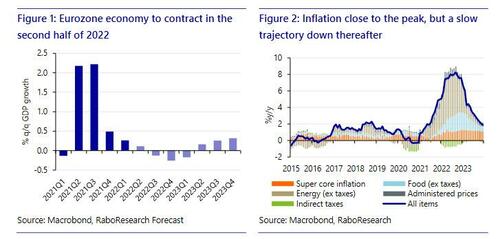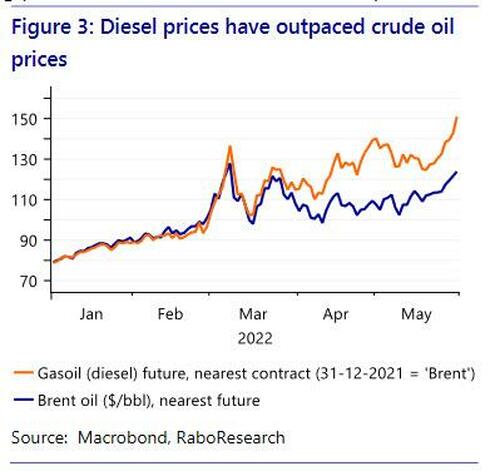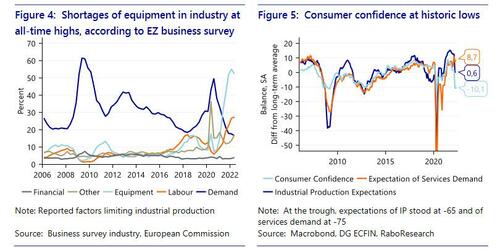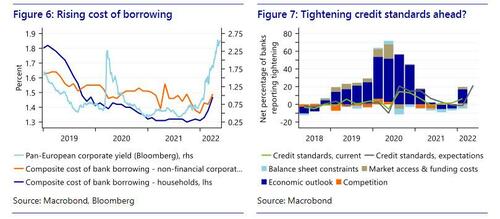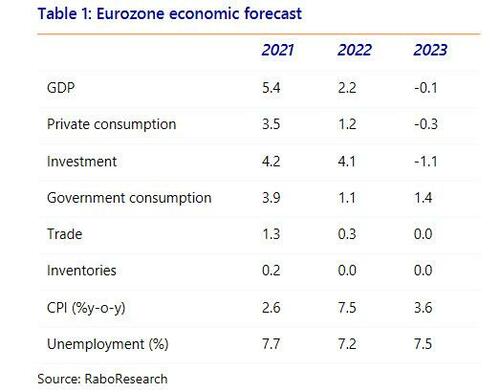The US Oil Boycott Of Russia Will Push The Eurozone Into A Recession
Excerpted from Maartje Wijffelaars, Elwin de Groot and Erik-Jan van Harn of Rabobank (full note available to ZH professional subscribers in the usual place).
Summary
-
On Tuesday night EU leaders agreed to ban all Russian seaborne oil imports
-
The ban, amid already high inflation and intense supply chain pressure, will push the Eurozone into a recession; this confirms our views expressed earlier this year
-
We expect the Eurozone economy to enter a recession by the end 2022/early 2023
-
Helped by carry over effects we still expect the Eurozone economy to grow by 2.2% in 2022, yet to contract with 0.1% in 2023
-
The ban will not lead to lasting energy shortages, but it will take time before Russian oil imports are replaced and oil prices will almost certainly trend higher
-
Our forecast is subject to quite some uncertainty, especially when it comes to the timing and depth of the recession. But, importantly, a grind down is in the works, with neither the ECB nor governments in the position to prevent that
EU leaders agree to ban seaborne oil imports
On Tuesday night, EU leaders agreed to ban all Russian seaborne oil imports. The sixth sanction package, including the details, still needs to be officially signed off, but based on earlier statements, import of Russian crude oil via seaborne shipments is set to be barred from the end of this year. The ban on seaborne import of petroleum products should then become effective about two months later. A “temporary” exception is being made for pipeline imports, to accommodate concerns over energy security for Hungary, Slovakia and the Czech Republic. When taking into account that Germany and Poland have said to cut Russian oil imports regardless of the exemption, the current agreement effectively means that about 90% of crude oil imports from Russia would be phased out by the end of the year- which represents around one quarter of total annual crude oil imports in the EU in recent years. It has not yet been agreed how long the exclusion of pipeline oil will last. Importantly, the package will also foresee in a provision to limit re-exports of Russian crude arriving via pipelines and petroleum products based on Russian crude oil.
Eurozone economy to shrink due to energy crisis
The oil boycott pushes us to downgrade our forecast. We had already highlighted this risk in previous research notes. We expect the Eurozone to enter a recession at the end of this year (Figure 1). Combined with carry over effects from the strong second half of 2021 this means that the economy is still set to grow in 2022, yet to contract in 2023. We have pencilled in growth of 2.2% in 2022 and -0.1% in 2023 -compared to, respectively, 2.9% and 1.5% in our previous forecast. Recently we had already lifted our inflation outlook to 7.5% this year and 3.6% next year, based on our expectation of a Russian oil embargo.
Oil embargo will fuel non-Russian oil prices
In our view, the Russian oil embargo will not lead to large lasting energy shortages. Yet adjustments are likely to take time and it will certainly fuel prices of both crude oil and refined petroleum products. In fact, this morning prices of both crude oil and refined petroleum products such as diesel already pushed higher (Figure 3). It is the price of refined petroleum products that is being felt most by households and hauliers and that price has in fact already seen much sharper increases than crude oil since Russia’s invasion. Driving factors of the so-called crack spread so far have been capacity constraints at refineries worldwide and less imports from Russia. For now, lockdowns in China will continue to cap the price of crude oil, but once China’s lockdowns are lifted, we envisage that the price of crude oil could peak at over $170 a barrel – as can be read in the oil ban scenario analyses we have conducted earlier.
Recession hits once reopening boost fades
In the first quarter of the year the Eurozone economy still managed to grow, with 0.3% q/q – revised upwards from 0.2% q/q. We also expect the growth figure to hold just above the zero- mark in the current quarter, on the back of (i) the grand reopening of the economy, (ii) businesses still working their ways through backlogs, (iii) rather strong labour markets in many Member States, and (iv) excess savings that allow households to absorb part of the higher prices regime.
Moving on to the third quarter, tourism activity is likely to benefit from the seemingly unstoppable drive of many to go on a holiday. Yet it will be ever more difficult for the economy to continue to post positive growth figures, as the boost of reopening fades amid very high inflation and equipment shortages. In our view, government support, already being ramped up across the block, will alleviate some inflation pressure and this should support economic growth by several decimal points. But it will not be able to prevent a downturn. Indeed, we are dealing with a supply shock induced crisis and you simply cannot solve a supply shock by ramping up demand. In fact, broad scale support might even accomplish the opposite, as it could support demand for which there is too limited supply.
Meanwhile, we currently assume China to continue its zero-covid policy, with alternating lockdowns continuing to put pressure on global supply chains. In our projections, we incorporate that it will take until the final quarter of the year for supply chain pressures caused by China to soften materially. We note, however, that China’s reopening -even when gradual- will also feed into higher prices for energy commodities and metals as Chinese demand for these commodities rises.
Supply chain disruptions and rising input prices hurt production
From a supply side perspective, input and equipment shortages are likely to continue to hamper industrial production over the coming quarters, as will increased input prices to the extent that they cannot be fully passed on to customers. In past months, production of energy intensive products in the EU, such as fertilizers, paper, and construction materials, has already been cut back due to elevated energy prices. Meanwhile, in surveys, businesses report lengthening delivery times and record equipment shortages (Figure 4). Important sources of the supply chain disruptions are lockdowns in China and the war in Ukraine. We expect input deliveries from China to continue to be hampered for the better part of the year, while we also don’t envisage the end of the war or a reduction in energy price -quite the opposite in fact when it comes to the price of oil, as explained.
On a positive note, the price of natural gas has come down over the past weeks and is almost back at its pre-war level, which should exercise some downward pressure on energy price inflation and support energy intensive production in the Eurozone. That said, it remains very high in historical context and has the potential to trend higher again.
Inflation and uncertainty hurt demand
From a demand side perspective, we expect the sharp and persisting price rises and growing uncertainty (Figure 5) to slowly ‘kill’ households’ ability and willingness to consume. Even though extra savings at European bank accounts accumulated during the pandemic (some 5% of annual GDP) will help to absorb the higher prices, a contraction in consumption is all but a given in our view. Both the magnitude of the inflation and the fact that savings are unequally distributed among households -with a decumulation of savings among low-income households- feed into this view. We foresee consumer spending to contract for several quarters, starting in the third quarter of this year. It usually takes time for higher inflation and uncertainty to translate into lower consumption growth, although the magnitude of both could well speed things up little when compared to history. We also believe that higher input costs and increased pessimism over the outlook will eventually lower the ability and willingness of businesses to invest, create jobs and raise wages.
In addition, over time, increasing financing cost are also expected to bite. Although the ECB still hasn’t raised rates so far, we expect it to start a tightening cycle in July, taking its deposit facility rate back to +0.25% by the end of the year. Market developments since the beginning of the year have already led to a considerable tightening of financial conditions; risk-free government bond yields, term and inflation risk premiums as well as corporate risk premiums have contributed to this. Whilst it could be argued that rates – both at the short and at the long end of the maturity spectrum – have not kept up with actual inflation rates, the fact that the bulk of the rise in inflation is due to a deterioration in the terms of trade, implies that one cannot compare these one for one. Indeed, the marked rise in long-term bond yields even when corrected for higher inflation breakeven rates since end-April underscores the higher interest rate environment. Together with the ongoing uncertainty over the outlook, this is also leading to a tightening of bank credit conditions, in terms of higher borrowing costs as well as a tightening in loan conditions.
As such, whilst higher inflation and supply shortages remain the key drivers of the economic slowdown, the tightening of financial conditions is likely to contribute to an ‘acceleration’ of the economic slowdown as time progresses.
Labor demand to contract
Over the coming months, when demand cools and pessimism among businesses increases, we will likely first witness a reduction in outstanding vacancies. An actual contraction of hours worked will then follow further down the line. To what extent this will lead to layoffs and higher unemployment is rather uncertain, however. Short-time work schemes introduced during the pandemic will very likely limit official employment destruction and the rise in unemployment – and hence income losses. Still, we believe that economic growth and unemployment are not fully disconnected, which is why we project unemployment to increase from 7.2% this year to 7.5% in 2023 and 7.8% in 2024 -compared to 8.6% at the pandemic peak. Meanwhile we project wages to grow by 2.5% on average this year and 3% next year. This clearly is an improvement from the growth of 1.5% in collective wage agreements last year, but is largely insufficient to keep up with inflation. Hence real wages, are set to shrink big time, underscoring our view of contracting consumption further down the line.
Risks to forecast are balanced
We are finding ourselves in uncertain times, yet again. Forecasting a recession, and the timing thereof, is fraught with risks. Whilst the direction of travel is clear to us, the depth of the crisis is less obvious. Indeed, the relationship between inflation, uncertainty and GDP growth is not set in stone -it could either be more or less intense than we currently foresee. Other important sources of uncertainty are the timing and impact of China’s reopening, and of government support in the Eurozone.
Finally, we currently only see it as a tail risk that the EU stops importing Russian gas in the short term or that Russia suddenly fully stops exporting gas to the EU on its own account. Admittedly, Russia has already stopped delivering gas to several smaller customers including Finland and particular providers in Germany and the Netherlands. Yet it would be a real financial blow for itself if it were to fully cut off large countries such as Italy and Germany, for example. Still, more unforeseen things have happened over the past months and both EU sanctions and Russian countermeasures are clearly a moving target. As such we keep a close eye on developments. In any case, while the recent stop in gas flows is likely to cause some price effect already in the countries hit, the consequences of a sudden full stop in Russian gas inflows in the EU would be much larger.
All in all, then, we regard the risks to our forecast rather balanced. Importantly, a grind down is in the works, with neither the ECB nor governments in the position to prevent that.
Tyler Durden
Wed, 06/01/2022 – 13:25
via ZeroHedge News https://ift.tt/JdNDc16 Tyler Durden
